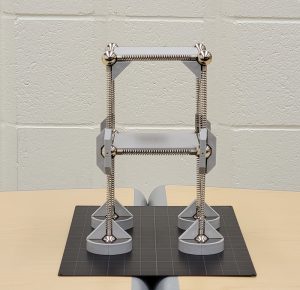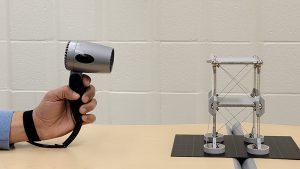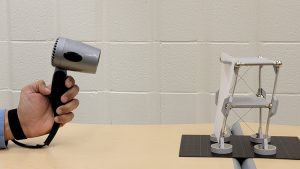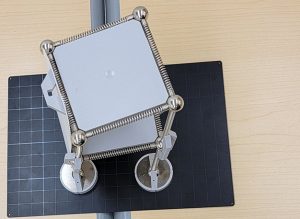The Technique
In my courses, I am keen on using innovative teaching techniques that enhance my students’ understanding of physics fundamentals and contribute to building their engineering skills. One example of these fundamentals and skills is the understanding of wind impact on structures, specifically “wind hazard,” as it relates to the sustainability of structures to resist the lateral load of wind.
We look at the effect/impact that wind has on structures and how to assess how the performance of the structure (deformation and stability) will vary with the change in the positioning of structural elements (bracings and connections). The goal of this activity is to find the right configuration of structural elements that ensures structural stability and so lower the impact of wind on the structure for a more resilient and sustainable design.
Since wind intensity and direction change all the time, I want to work with my learners to examine different wind intensities (lateral loads) and directions and to demonstrate how this will impact the structural performance. I start this process by first demonstrating the different structural systems that we have in the two perpendicular directions of the structure (X and Y directions), where one direction is a moment-resisting frame (MRF) and the other direction is a braced frame (BF). It is expected that, for the same frame dimensions, the BF will perform better than the MRF.
From this demonstration, I want them to build things that will stand the test of time and human interaction. Using an interactive structural kit enables my students to build real models that they interact with, which will be engraved in their minds as they develop their engineering skills.
They use the kits to find the “point of depreciating returns,” meaning that they will use the ideal amount of materials while still protecting the sustainability of the structure!
How I use It
Learners receive their interactive structural kits and then I get them ready to work in their groups. Each group needs to build a model that has a different structural system in the X and Y direction (MRF and BF).
 |
versus |  |
- I introduce the first activity and challenge learners to test both directions without placing the facade of the structure (a piece of paper) where wind is applied, using a source of air (i.e., a hair dryer). This demonstrates that the wind load only develops when the wind pressure is applied on the outer “outer area” of the structure.
- Next, I place a piece of paper as a facade for the structure so that the performance of both structural systems (MRF and BF) are shown as more deflection will be developed by the MRF compared to the BF.
 |
versus |  |
Moving on to the second activity:
- The next set of activities aims to show the importance of distributing the rigidity of the lateral load resisting system to avoid the torsional effect for the structure. I set the challenge by asking students to remove one side of the pressing. This concentrates the rigidity of the system on only one side. After applying the wind load, I ask learners to identify the effect/result (which should be the torsional effect visualized from the twisting encountered by the structure around its vertical axis, which will create additional straining actions on its columns).
 |
 |
And then to the final activity:
- I challenge learners to show the effect of eliminating the corner fixation for the MRF. In this activity, learners must demonstrate how the structure becomes unstable and completely collapses under the wind load. This final step demonstrates the importance of using an effective design to ensure its ability to sustain the applied bending moment with the most efficient use of materials in its build.
Feedback from Learners
Experiencing an interactive technique where you can see the impact of changing your design is something unique, which I am passionate about showing to my students.
After demonstrating the use of this interactive structural kit, when compared to other approaches (showing figures and calculations), students commented that it was a unique experience as they got the chance to physically see the deformed shape of a structure and experience the actual instability of a structure.
Supporting goal 11
Make cities and human settlements inclusive, safe, resilient, and sustainable
This teaching technique inspires our young generation of engineers to build more resilient and sustainable structures, which will ensure a safer built environment and optimal use of building resources.
A short task to challenge you!
In an effort to better understand strength and stability, and to have a bit of fun with everyday objects try the following:
One Final Task
Is this something you can use in your classroom? How might you utilize it? If you share your results somewhere on social media, link to this lesson for context.


Feedback/Errata